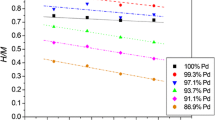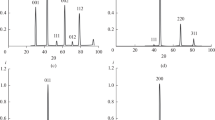Conclusions
-
1.
The thermal stability of ruthenium phosphides in air diminishes with increase in their phosphorus content. The initial vigorous oxidation temperature is 600 for ruthenium, 590 for Ru2P, 390 for RuP, and 270°C for RuP2. These temperatures must be regarded as the limits of thermal stability of these substances in air.
-
2.
The oxidation of the phosphorus in the phosphides has a stepwise character. The first to oxidize are phosphorus atoms which can be reached most readily by oxygen. Phosphorus atoms located in the octahedral voids oxidize more slowly, together with ruthenium atoms.
-
3.
Under polythermal oxidation conditions the maximum weight gain temperature for these phosphides falls with increase in their phosphorus content.
-
4.
The end products of the oxidation are P2O5, which sublimates, and RuO2.
-
5.
On heating in argon Ru2P and RuP melt, without decomposing, at 1500 and 1555°C, respectively, while RuP2 decomposes at 950°C.
Similar content being viewed by others
Literature cited
W. Biltz, H. I. Ehrhorn, and K. Meisel, Z. Anorg. Chem.,240, 121 (1938).
F. Hulliger and E. Mooser, J. Phys. Chem. Solids,26, 429 (1965).
D. M. Matthews, US Pat. No. 3664829, May 23 (1972).
D. V. Ignatov, É. M. Lazarev, et al., in: Structure and Properties of Single Crystals of Refractory Compounds [in Russian], Nauka, Moscow (1973), p. 98.
Iu. A. Kocherzhinsky, Étude de Transformations Cristallines à Haute Température au dessus de 2000°K (1971), p. 47.
Yu. A. Koeherzhinskii, N. A. Bezshtan'ko, V. I. Vasilenko, et al., Izv. Sibirsk. Otd. Akad. Nauk SSSR, Ser. Khim. Nauk,4, No. 9, 32 (1974).
G. V. Samsonov, Nitrides [in Russian], Naukova Dumka, Kiev (1969).
G. V. Samsonov and L. L. Vereikina, Phosphides [in Russian], Izd-vo Akad. Nauk UkrSSR, Kiev (1961).
J. Benard, Oxidation of Metals [Russian translation], Vol. 1, Mir, Moscow (1968).
H. Schäfer, G. Schneidereit, and W. Gerhardt, Z. Anorg. Chem.,319, 327 (1963).
Author information
Authors and Affiliations
Additional information
Translated from Poroshkovaya Metallurgiya, No. 3(159), pp. 16–19, March, 1976.
Rights and permissions
About this article
Cite this article
Ghernogorenko, V.B., Semenov-Kobzar', A.A. & Kulik, L.Y. Oxidation resistance of ruthenium and ruthenium phosphide powders in argon and air. Powder Metall Met Ceram 15, 178–180 (1976). https://doi.org/10.1007/BF00806520
Received:
Issue Date:
DOI: https://doi.org/10.1007/BF00806520




